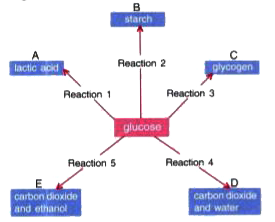Mention the important series of events of aerobic respiration that occur in the matrix of the mitochondrion as well as one that take place in inner membrane of the mitochondrion.
Step-by-Step Solution:
1. Understanding Aerobic Respiration:
- Aerobic respiration is a metabolic process that occurs in the presence of oxygen. It is essential for the production of ATP, the energy currency of the cell.
2. Events in the Matrix of the Mitochondrion:
- The Krebs cycle (also known as the citric acid cycle or TCA cycle) occurs in the matrix of the mitochondrion.
- The process begins with the oxidation of pyruvate, which is the end product of glycolysis.
- Pyruvate combines with acetyl-CoA to form citric acid.
- Citric acid undergoes a series of transformations through several steps, eventually regenerating oxaloacetate, which can combine with new acetyl-CoA to continue the cycle.
3. Events in the Inner Membrane of the Mitochondrion:
- The inner membrane of the mitochondrion is where the electron transport chain (ETC) takes place.
- The ETC consists of four protein complexes (Complexes I, II, III, and IV).
- Electrons are transferred through these complexes and ultimately to oxygen, which acts as the final electron acceptor.
- During this process, hydrogen ions are also exchanged, contributing to the creation of a proton gradient that is used to generate ATP.
Summary of Important Events:
- Matrix of Mitochondrion: Krebs cycle (complete oxidation of pyruvate to produce energy-rich molecules).
- Inner Membrane of Mitochondrion: Electron transport chain (transfer of electrons to oxygen, producing ATP).
---
- Aerobic respiration is a metabolic process that occurs in the presence of oxygen. It is essential for the production of ATP, the energy currency of the cell.
- The Krebs cycle (also known as the citric acid cycle or TCA cycle) occurs in the matrix of the mitochondrion.
- The process begins with the oxidation of pyruvate, which is the end product of glycolysis.
- Pyruvate combines with acetyl-CoA to form citric acid.
- Citric acid undergoes a series of transformations through several steps, eventually regenerating oxaloacetate, which can combine with new acetyl-CoA to continue the cycle.
- The inner membrane of the mitochondrion is where the electron transport chain (ETC) takes place.
- The ETC consists of four protein complexes (Complexes I, II, III, and IV).
- Electrons are transferred through these complexes and ultimately to oxygen, which acts as the final electron acceptor.
- During this process, hydrogen ions are also exchanged, contributing to the creation of a proton gradient that is used to generate ATP.
- Matrix of Mitochondrion: Krebs cycle (complete oxidation of pyruvate to produce energy-rich molecules).
- Inner Membrane of Mitochondrion: Electron transport chain (transfer of electrons to oxygen, producing ATP).
Topper's Solved these Questions
- BOOK - NCERT EXEMPLAR ENGLISHCHAPTER - RESPIRATION IN PLANTS EXERCISE - LONG ANSWER TYPE QUESTIONS5videos
RESPIRATION IN PLANTS
- BOOK - NCERT EXEMPLAR ENGLISHCHAPTER - RESPIRATION IN PLANTS EXERCISE - VERY SHORT ANSWER TYPE QUESTIONS7videos
RESPIRATION IN PLANTS
- BOOK - NCERT EXEMPLAR ENGLISHCHAPTER - PLANT KINGDOMEXERCISE - LONG ANSWER TYPE QUSTIONS5videos
PLANT KINGDOM
- BOOK - NCERT EXEMPLAR ENGLISHCHAPTER - STRUCTURAL ORGANISATION IN ANIMALSEXERCISE - long answer type questions5videos
STRUCTURAL ORGANISATION IN ANIMALS
Similar Questions
Knowledge Check
- Question 1 - Select One
Consider the following statements with respect to respiration.
(i) Glycolysis occurs in the cytoplasm of the cell.
(ii) Aerobic respiration takes place within the mitochondria.
(iii) Electron transport system is present in the outer mitochondrial membrane.
(iv) C51H98O6 is the chemical formula of tripalmitin, a fatty acid.
(v) Respiratory quotient =Volume ofO2evolvedVolume ofCO2consumed of the above statementsA(i),(ii) and (iv) are correctB(ii),(iii) and (iv) are correctC(iii),(iv) and (v) are correctD(ii),(iv) and (v) are correct - Question 2 - Select One
Study the following statements regarding mitochondria and select the correct ones.
These are the sites of aerobic respiration.
(ii) Matrix contains single, circular ds DNA molecule, a few RNA molecules, 70S ribosomes.
(iii) Mitochondria divide by fission.
(iv) Mitrochondria are fully-autonomous.A(i) and (ii)B(iii) and (iv)C(i), (ii) and (iii)D(i), (ii), (iii) and (iv) - Question 3 - Select One
Which one of the following events takes place after double fertilisation ?
AThe pollen grain germinates on the stigmaBThe pollen tubes enter the embryo sacCTwo male gametes are dischared into the embryo sac.DThe PEN (Primary Endosperm Nucleus) develops into endosperm.
Supply the specific scientific terms for the following:
stalked particles on the inner membrane of a mitochondrion.View SolutionWhat are the main steps in aerobic respiration? Where does it take place?
View SolutionWhat important events take place in interphase?
View SolutionWhich stages of aerobic respiration take place in matrix of mitochondria
(i) Oxidative decarboxylation of pyruvic acid
(ii) Glycolysis
(iii) Krebs cycle
(iv) Oxidative phosphorylationView SolutionGiven below are chemical reactions (1 to 5) involving glucose and five other chemical products (A-E).

(a) Write the reaction number of the following:
(i) Anaerobic respiration in plants .........
(ii) End-products in aerobic respiration ...........
(iii) Reaction occurring in liver ............
(iv) Anaerobic respiration in animals ................
(v) Storage in the liver..............
(b) Which reactions (1-5) in the above correspond to the following (write the corresponding number of reaction next to them).
(i) Aerobic respiration
(ii) Change taking place in the liver
(iii) Anerobic respiration in yeast.
(iv) Change taking place in a plant storage organ, e.g., potato.
(v) Anaerobic respiration in animalsView Solution

